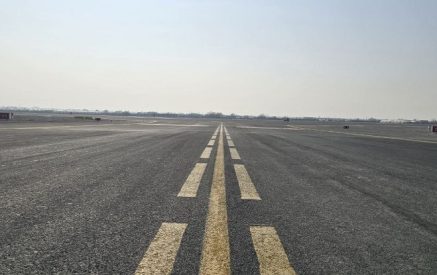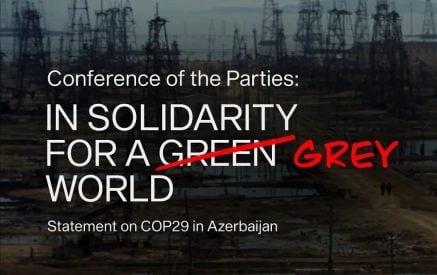Monte Melkonian, 24.09.1990
All throughout the world environmental issues are rapidly becoming a high priority. Popular consciousness concerning the environment has been long overdue, and despite considerable advances it still remains at a level much too low to correspond with its truly pressing importance. Huge, widespread and irrepairable damage has already been done to a vast proportion of our planet’s waters, landmass and atmosphere. Hundreds (if not thousands) of species of plant and animal life have gone extinct within the past 30 years alone while many scientists estimate that at least 2 species of plant life go extinct every day. The combination of the depletion of the ozone, greenhouse effect, acid rains, worldwide pollution (not to mention local forms of pollution and contamination), and the destruction of both tropical and non-tropical forests is causing damage similar to that of a gradual nuclear and chemical world war. The complex interdependence of the world’s ecological systems gives such a trend awesome implications for the future of humankind.
A long and complicated series of interrelated factors is responsible for this rapid and ever accelerating degradation of the world’s environment.
Capitalism
Ever since its birth during the “Industrial Revolution” capitalism’s “logic” has called for maximum and quick profit-taking through – among other things – the lowest possible cost for production. This has meant a drive toward the cheapest possible (i.e. most extreme) exploitation of both human and material resources. Short term monetary profit instead of the long term interests of people, natural resources and the world’s ecology have dictated the (mis)use of our collective environment. Capitalist vision tends to extend at most over the lifetime of a single person and usually over only a decade, a few years or even a few months. Though the life time of one capitalist is very short compared to the world’s evolutionary process, it is plenty long to cause severe, long term and sometimes permanent damage to our environment. The “natural” demands of maximum profit usually go head-on against the demands of our natural habitat. Today it is this trend which constitutes the driving force behind the degradation of our planet. The vast majority of the world’s population (let alone nature itself) has absolutely no say in the huge multi-national corporations’ “development projects” which include the intensive and often indiscriminate fish depletion (e.g. dragnet “fishing”) of our seas and oceans, the rape of underground mineral resources, the massive burning and chopping of forests, the easy “elimination” of toxic wastes by pumping millions of tons of them daily into our rivers, oceans and atmosphere, the intensive use of fertilizers and insecticides which contaminate our soils and water systems, the waste of huge proportions of raw materials through the mass production of certain superfluous consumer commodities and non-recyclable packaging, etc., etc. Thus, as long as the subordination of our environment, resources and nature to intensive and relatively short term profit making continues we can only expect a rapid degradation of our collective habitat. Such degradation can only lead to a drop in the quality and pleasure of human life as well as eventually a possible end to Earthly life as we know it today.
Centrally Dictated Economies
Though capitalist intensive profiteering has been the major driving force behind environmental destruction, it has not been alone. While socialist methodology originally set the theoretical framework for the more rational use of our resources and the subjugation of production to the collective democratic will of the workers and populations concerned, in practice none of these principles were effectively respected. In fact, in many cases certain “socialist” governments designed and implemented projects based on the heavy, unrestricted destruction of the environment. Again such so-called “socialist” schemes – like their capitalist counterparts – were guided by short term “interests” (themselves defined by a relatively small group of people who were usually not in immediate or continuous contact with each specific situation) and led to ecological disasters. In addition, the irrational and inefficient production, distribution and storage systems of many “socialist” countries resulted in the massive waste of raw materials and agricultural products. All of this not only caused major environmental problems but also a major factor which contributed to these countries’ present economic crisis. This is extremely ironic since for decades those who planned these economies “justified” environmental damage as “a necessary sacrifice to build a strong economy”.
Thus, both of the major modern economic systems have worked to create our planet’s present environmental crisis. Capitalism has done this since environmental exploitation is integrated into its own “logic”, and centrally dictated economies have achieved this through the violation of their own theoretical principle and the stubborn continuation of absurd trends. Another unfortunate outcome of all this has been that a huge proportion of the world’s population is now more cynical than ever about the ability of any modern economic system to avoid – let alone reverse – the gradual nuclear/chemical war effect.
Demography
This pessimism is largely valid if another major (perhaps eventually the single most important) factor in environmental destruction is not reversed: the ever increasing over-population of the Earth. Not even the most efficient, well-researched, balanced and rational economic system, will be able to insure basic human needs or the conservation of nature and raw materials if present trends in demographic growth are not reversed on both a regional and global basis. Our planet comprises a very finite ecological habitat which is constantly shrinking both in relation to the expanding human population and to the non-renewable resources being exhausted. Much hope has been put on technology to cope with the needs of our geometrically multiplying numbers; however, scientists (and the general public) are now realizing that within our finite habitat technology has its limits. Intensive use of fertilizers and insecticides has ended up putting great strain on top soil while polluting the lower earth layers, underground water reserves, rivers and the seas. Hybrids may offer a partial answer, but in the end they can produce no more than the sun, soil, water and atmosphere allow them to. As long as the world’s population grows new areas and methods will be needed for food production. The experience nature has given us, especially during the last few decades, makes it clear that whatever we do will have its repercussions on the ecological system. Also, any “solutions” will only be temporary as long as demographic growth multiplies our basic necessities. Furthermore, food is only one dimension of the crisis. Energy, housing, clothing, transportation, education, medicine and the long list of social and cultural needs to achieve modern standards for healthy human life will all have to be produced somehow. And here we’re not talking about superfluous consumption but rather about the rational, normal, yet expanding demands of modern life.
First let’s look at the historical background to this crisis.
While colonial exploitation and the “Industrial Revolution” gave Europe the means to increase its rate of population growth at an early date, other continents had different paths of development.
South, South-East and East Asia developed relatively large populations through their thousands of years of organized society and civilization. The large river basins, adequate rainfall and rich land allowed many regions to support large populations. Despite remaining primarily agrarian throughout most of history these civilizations created major urban centers and developed various forms of technology which served agriculture, artisanry, construction and trade. Thus, they had a “head-start” in the population explosion and are presently the most populated regions of the world.
The case of Africa was quite the opposite. Much of the continent does not lend itself to dense human habitation (deserts, thick forests, etc.). The overall population (discounting certain specific regional fluxes) tended to increase relatively slowly, and during the centuries of colonial rule when slave trade was widely practiced millions of villagers were forcibly shipped out or dried along the way. This, added with other tyrannic colonial policies on the continent (wars, massacres, confiscation of land, killing of wild life, etc.) probably even diminished the total population. During the last centuries there were considerable waves of immigrants
From Europe, China and India, but it has only been during the past few decades that a true demographic explosion has occurred. Presently almost all African countries have a high birth rate with some populations growing at 5% a year! Alongside the drop in agricultural and raw material prices, the debt crisis, foreign intervention in key economic sectors, etc. population growth is an important factor which stunts the development of many countries and which has even helped push them into further poverty. In some regions its pressure on the environment has been so great as to radically change the ecology.
Before European colonization both North and South America were relatively sparsely populated. The native civilizations of Central and north-western South America created important urban centers, hence denser populations, but on the whole the total continental population was low. With colonization millions of Native Americans were massacred, worked to death as slave, starved by being denied their traditional ways of life, and decimated by disease. This population decrease was counter-acted by massive immigration from Europe and millions of slaves brought from Africa. Later immigration continued from all parts of the world. Today the population boom is well on its throughout Latin America while the high consumption rate of the USA and Canada make their populations (that of the USA is in absolute terms already very large) some of the most burdensome for the environment.
In Oceana the pattern has in many ways paralleled that of the Americas. The region as a whole was relatively sparsely populated until European colonization began. Native populations were often ruthlessly repressed and driven into the less easily inhabitable territories. Further mass immigration came from South and East Asia. Today native peoples often constitute less than half – and in cases, only a very small proportion – of each country’s total population. While Australia is relatively “sparsely” populated by today’s standards (“standards” which lean much too toward over-populated) certain island states have denser populations.
In the case of Europe populations mostly began accumulating during the past 200-300 years when the effects of the “Industrial Revolution”, financed by the sapping of colonies throughout the world, allowed for larger populations to drive a living from non-agricultural work. Large concentrations in urban centers became feasible, and the cities began to absorb more and more of the excess rural population. Medicine also advanced in this part of the world. These factors gave Europe a relative “head-start” in the world demographic explosion. The geometric progression continued into the post-W.W.II years. The leveling off of the growth rate has only been quite recent. A combination of social security and retirement programs, successful education, increased possibilities for social and cultural activities, the advancing status of women, and easily available facilities for contraception has resulted in a general slowing of population growth and in some cases a very gradual trend toward demographic decrease. Most countries are already relatively densely populated and have exhausted vast proportions of their natural wealth. However, many of the capitalist states – especially the larger companies dealing in consumer commodities – consider the relieving of demographic pressure as “crisis” (while overlooking the real crisis of over-population). This surprisingly irrational view is based on the very shortsighted and selfish refusal to accept a drop in sales (and therefore, profits) within the immediate and extended futures. It is no wonder such companies are lobbying for a variety of government policies favoring large families, and some are even adopting a “benevolent” image as “baby lovers”. France is one country where this selfish and self-destructive view has gotten a foothold in many political circles. France has already shrunken considerably as a world force, so the state is very uncomfortable with the realization that a drop in the population may mean a drop in over-all industrial output as well as a smaller army. In today’s world the French people, the French countryside and France in general would be much better off both with less for intensive industry and with a smaller army, but these companies and the political circles they finance are portraying having babies as a “patriotic deed”. Thus, capitalism has created yet another dilemma for itself: the more it advances and gives concessions in the social sphere the more population growth slacks off creating a smaller market (which it will not forever be successful in making up for through exports).
Though commonly referred to as “socialist” for the past 70 years or so the centrally dictated economies of our world have not lived up in many, many respects to their name. We already mentioned the failure to deal with the environmental question. In the realm of demographic policy mistaken approaches were also applied. In many cases demographic growth was encouraged and adopted as official policy. The most extreme example of this was Ceaucescu’s regime which forbade any contraceptives, but at various periods during its history the USSR also went to extremes to increase birth rates (and today the country is not able to provide its population with adequate food, housing, clothing or services). The first country to draw up a serious demographic control policy was the Peoples’ Republic of China, but this came so late that a lot of environmental and economic damage has already been done thus increasing human suffering and postponing the progress necessary (especially infrastructural, social and economic) to achieve a steady rise in the standard of living. In many other countries where sincere efforts have been made to raise living standards rapid population growth has been oat-distancing and rendering insufficient vast amounts of hard, costly work (e.g. Vietnam, Mozambique, to some extent Nicaragua, etc). By the time infrastructure and facilities are set in place they are already overburdened by the expanded population.
At any rate, as in industrialized capitalist states, the conditions produced by the relatively developed “socialist” states (namely social security and retirement, health care, enhanced status of women, social and cultural activities, education, etc.) have tended to cause a slowing down of birth rates despite government policy to encourage them. Unlike the agrarian economies of the past where each child meant new income for the family, in modern industrial economies each child brings a new financial burden. This, social security, education and the ability to engage in creative activity other than procreation are the driving factors in leveling the demographic curve. Indeed, any economic system which claims to defend the interests of the human species should have as one of its major goals the creation of the material, cultural and educational means necessary to enact voluntary demographic decrease. Our environment demands this.
Now we may ask: how large a population can the world support? Where or what number will be its limit? Such questions are difficult to answer in any absolute manner; however, what is certain is that the greater the human population, the greater the strain on the environment becomes. The ozone holes, greenhouse effect, aid rains and widespread pollution show that this strain is already becoming fatal for our planet. We have probably already gone beyond the healthy limits for human numbers on Earth. Only about 200 years ago the total world population was less than one billion. 35 years ago it was “only” 2,5 billion. Today it is about 5,2 billion and growing by about 85 million a year. Never since Earth’s creation has the planet experimental with such a huge human population, and never in human history has each individual’s material needs been so great. Moreover, it is generally predicted that the present population will double within the next 40 years (or less), and some predict it more than tripling within the next century (despite growth leveling off or even slightly reversing in certain countries). Already of the over 5 billion up to 3 billion are estimated to be living in poverty conditions[1]. Over one billion (some say up to 2 billion) are undernourished, malnourished or starving. An even greater number live in inadequate housing (or none at all), and an even greater number than that (well over 3 billion) have a very low level or no education and/or health services. These statistics put our continuing rapid demographic growth into a rather dismal perspective for the future.
It is absolutely true that today’s crisis is aggravated by economic systems which short sightedly exploit, mismanage and divert resources and natural potential. Underdeveloped countries, where poverty is worst and most widespread, are being drawn into a vicious circle where they have little other option (expect popular revolution – but even after successful revolutions the pressure persists, e.g. Nicaragua, Mozambique, etc.) than to hand over their raw materials and agricultural produce at rock bottom prices to the rich industrialized countries in an effort to starve off immediate economic collapse. If the arm-twisting and coercive sapping which characterize much of today’s unequal trade were replaced by truly cooperative, long term mutually beneficial relations then much of today’s suffering would be remedied. Furthermore, if within each country resources were more evenly distributed and their use subjected to the democratic will of the populations concerned then present potential would already be enough to properly feed, clothe, house and educate a huge proportion of those who are presently denied these basic needs. People all over the underdeveloped world are aware of this, and that’s why revolutionary movements are still gaining momentum. However, this does not mean that even the most efficient use of a country’s resources will enable it to meet the needs of its whole population. This is true for many densely populated countries already, and it will probably only get truer for just about every country on earth as demographic expansion continues. What is certain is the larger any country’s population the greater the strain on its environment, regardless of which economic system is in play.
The population boom and its effect on our environment is a problem which is common to all economic systems and which plagues just about every country. In today’s world no system or government can be deemed truly responsible if it does not have as a function the control and reversal of demographic growth. Ideally this should be through the creation of the material and educational foundations necessary for voluntary population decrease.
The National Question’s Interrelation with Demographic Growth
It is in this perspective of a changed and yet changing, world where population growth is a major factor in weakening economies, spreading poverty and destroying our environment that we must review the place the national question occupies in this phenomenon. Both ecology and economy are making it clearer and clearer that population growth is against the qualitative interests of human life and could lead to catastrophe. This is now true even for relatively sparsely populated countries like Mongolia, Namibia, Paraguay, Australia, etc. where governments would be wise to draw out long term demographic policies right now instead of waiting until they are caught in the same vicious circle of over-population, poverty, ecological degradation,…[2]
For countries whose frontiers are not historically litigious and whose population (or at least its vast majority) is comprised of one national entity the problem of demographic growth can be approached in a relatively straight forward manner. However, hundreds of years of wars, empire building, colonialism and territorial rivalry have made today’s world map a very odd puzzle indeed. Only a minority of countries have frontiers which more or less accurately represent a single and integral national homeland. This is not only true in Africa where most borders have been inherited from colonial time when European cartographers – backed up by their respective armies – delineated their spheres of conquest with absolutely no regard whatsoever to the history or ethnic make-up of each region. It is just as true in “civilized” Europe where a country like France includes Corsica, half of Catalogna, part of Euskadi (the Basque homeland), Bretagne and Alsace (not to mention colonies on other continents). The world’s present irrational, and largely involuntary, borders have destructive and destabilizing consequences in many domains. Everything from large scale war to individual psychological disorders can be attributed, in full or in part, to today’s geo-political puzzle which does not correspond with historic and ethical/national realities.
The geographic aspect of the national question is closely related to the demographic aspect. Due to in correct administrative or political frontiers dozens (if not hundreds) of ethnic and national groups all over the world consider it a “national duty” to have as many babies as possible. Often this trend continues despite intense overcrowding. The Palestinians are a case in point. They consider rapid population growth (even in overcrowded Gaza) a necessary means to prevent themselves from losing a foothold in their homeland, to eventually regain majority status and meanwhile to fill their military forces with fighters. In view of Zionist policies and the lack of hope for any historically based solution they are quite correct to associate their numerical growth (even in overcrowded Gaza) a necessary means to prevent themselves from losing a foothold in their homeland, to eventually regain majority status and meanwhile to fill their military forces with fighters. In view of Zionist policies and the lack of hope for any historically based solution they are quite correct to associate their numerical growth with the future of their people. Northern Ireland, Tamil Eelam, the people of the Amazon and Orinoco river basins, the Sikhs, etc., etc. are just a few examples of some better-known cases where rapid population growth has been considered necessary to preserve the existence of a people. Of course, one other case is our won.
The Armenian Case today: As argued before (see The Right to struggle) though demography is one aspect affecting the national question, national rights cannot be simplistically boiled down to contests in reproduction or migration (especially politically motivated migration to alter the original national make-up of a given region). In a world directed by objective, rational thinking no people should feel they have to produce as many babies as possible to insure national existence. However, today’s world is still largely dominated by aggressive, chauvinistic, colonial, exclusivist, and unbalanced policies which promote short-sighted or narrow interests. (So much for all that talk about “modern civilization”). The Armenian people have long suffered from such policies. In substance little has changed today since our national existence is still threatened by similar confrontational policies. It is these policies which have driven the vast majority of Armenians to consider childbearing a “patriotic duty” and necessary step to insure national existence.
While in most parts of the diaspora, due to strong trends toward assimilation, having children no longer necessarily means increasing the numbers of Armenians (see The Right to Struggle) within Armenia it does work. Indeed the birthrate there is rather high, especially for the Soviet Union. However, Armenia is already much more densely populated than most countries[3]. Much of its territory does not lend itself to anything but sparse human habitation while both agricultural land and valuable raw materials are relatively scarce. There are shortages in basic necessities: food, housing, electricity, medical care, etc. Furthermore, everyone is now well aware of the extent of ecological damage – damage which has already had repercussions both on nature and on many person’s biology, including babies’. Of course, a great deal of the ecological damage was due to totally inappropriate industrial projects, the arrogant low-cost dispense of wastes, and the squeezing of nature to achieve the quantitative goals of each 5 year plan. Nevertheless, like everywhere else, so too in Armenia a larger population means more strain both on ecology and on the economy. In view of all this we must rethink the question of population growth, its possible and negative effects.
We have already skimmed over some of the negative aspects, so let’s now turn again to how demography is affecting prospects for national future. In Armenia itself the population is 90% Armenian, so that region of our homeland is in no danger of becoming demographically “un-Armenian”. The only things that could change this (within the middle-term future) would be an invasion by the Turkish army, a nuclear war or a yet unimaginable ecological disaster. Emigration from Armenia is on the rise, but it is unlikely this will leave the country with a majority non-Armenian population – at least provided the economy doesn’t go completely broke.
The situation in Artsakh (including the areas between Nagorno Karabagh and Armenia) and Nakhichevan certainly do call for concern regarding demography. Both areas have been subject to official Azerbaijani policy to depopulate them of their Armenian inhabitants and repopulate them with Azeris. In the case of Nakhichevan this has been largely successful (though this does not mean this region should not be reintegrated into Armenia – see The Right to Struggle). In the case of Artsakh the policy has only been partially successful, thus the overwhelming majority 70 years ago has fallen to about 75% now (still very important). However, within the past 2,5 years the Azerbaijani authorities have stepped up their anti-Armenian repression in all domains including military attacks and coercive deportation. Hence maintaining an Armenian majority in these regions is an important part of the struggle for their national self-determination.
In Akhalkalak the Armenians are a majority, but there are signs of trends to depopulate there, too.
On the other side of the border, in Turkey, the situation is especially bad. The genocide and state sponsored repression which continues until today has left the area with almost 4 million inhabitants, only about 20 or 30,000 of which are Armenian (or consider themselves Armenian). Again here demographic factors will come to play in any future redefinition of politico-administrative frontiers. If the geographical sphere of a future democracy is defined as the entire historic Armenian homeland and thus the demographic domain as all those attached to that homeland (i.e. all Armenians who live or will live in any part of that homeland plus all other inhabitants historically based in the region), then today’s total Armenian population already present there (without counting any diaspora immigrants whatsoever) would wake up a plurality (relative majority) but not an absolute majority of the total population. These are the facts today, but with emigration from Armenia and the higher growth rate across the border (2.8% per year compared with Armenia’s prior rate of slightly over 2% per year) things may be quite different within a decade or so[4]. Since the majority of the Armenian homeland exists within Turkey if any efforts to reunite all parts of it are to be envisaged the demographic factor must be addressed.
*
Unlike in most of my texts, here I will not draw any conclusions and I will stop short of making practical proposals. The purpose of this essay was to put a question which has not yet been seriously addressed on the table for discussion. Until now most Armenians have just taken it for granted that the more babies you have the better. Today there is still understandable “pressure” to have many children due to the lack of an objective, peaceful solution to the Armenian national question; however, it is becoming more and more apparent that ecological balance and economic development, which are also essential for our nation’s future, do not coincide with the over-population of that part of our homeland where an Armenian state exists today. My only general advice at the moment is:
The priority today both in the diaspora and in our homeland must be the quality of life and the quality of each person, rather than an absolute emphasis on quantity. (Here by “quality of life” I do not mean how rich or consumer-oriented one is. Rather I am talking about moral, educational and intellectual development as well as physical health.)
The Armenian people and their state structure must formulate a demographic policy for long term development that will formally recognize the exigencies of our yet unresolved national question as well as the necessities for environmental reconstruction and economic progress.
The struggle for the reunification of our homeland and people should work to win over all inhabitants of the Armenian homeland, whether Armenian or non-Armenian.
[1] Note: I have read many different estimates which vary in their statistics, but all disclose a very large-scale, world-wide human crisis. Here I will state round figures which hopefully represent the general situation. What is important is that people recognize the trends and realize the present degree of crisis.
[2] Note: According to demographers a drop in the world’s population – through natural and voluntary means – will only be possible if all couples restrict themselves to a single child born after both parents have reached at least the age of 30.
[3] Note: Here “Armenia” refers to all territories under the administrative control of the Armenian government, thus we are not including the majority of the Armenian homeland, especially those areas presently in Turkey.
[4] Note: For a more detailed discussion of this subject see The Right to Struggle.


























































